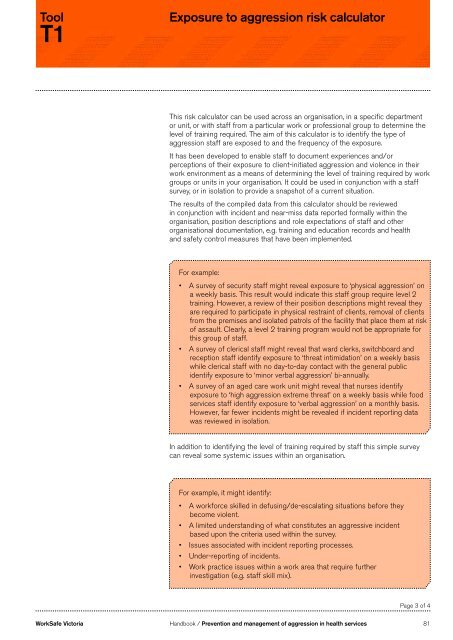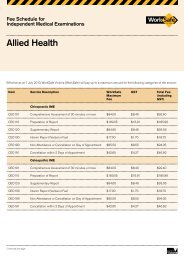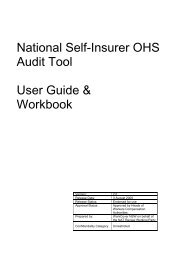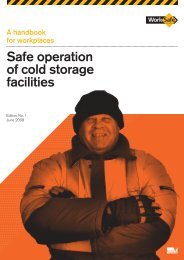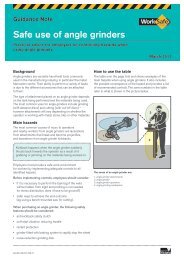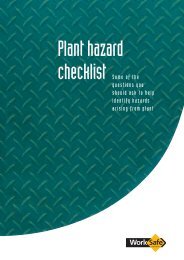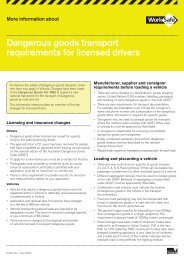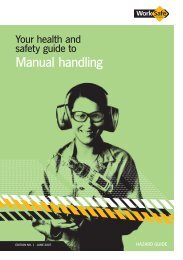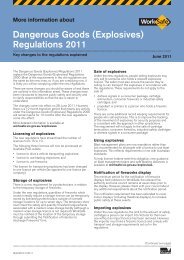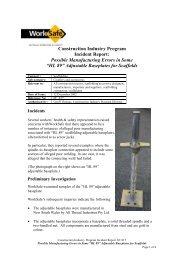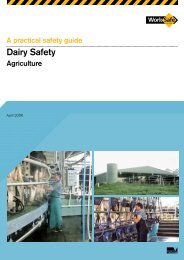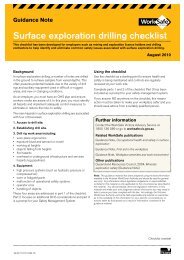Prevention and management of aggression in ... - WorkSafe Victoria
Prevention and management of aggression in ... - WorkSafe Victoria
Prevention and management of aggression in ... - WorkSafe Victoria
You also want an ePaper? Increase the reach of your titles
YUMPU automatically turns print PDFs into web optimized ePapers that Google loves.
ToolT1Exposure to <strong>aggression</strong> risk calculatorThis risk calculator can be used across an organisation, <strong>in</strong> a specific departmentor unit, or with staff from a particular work or pr<strong>of</strong>essional group to determ<strong>in</strong>e thelevel <strong>of</strong> tra<strong>in</strong><strong>in</strong>g required. The aim <strong>of</strong> this calculator is to identify the type <strong>of</strong><strong>aggression</strong> staff are exposed to <strong>and</strong> the frequency <strong>of</strong> the exposure.It has been developed to enable staff to document experiences <strong>and</strong>/orperceptions <strong>of</strong> their exposure to client-<strong>in</strong>itiated <strong>aggression</strong> <strong>and</strong> violence <strong>in</strong> theirwork environment as a means <strong>of</strong> determ<strong>in</strong><strong>in</strong>g the level <strong>of</strong> tra<strong>in</strong><strong>in</strong>g required by workgroups or units <strong>in</strong> your organisation. It could be used <strong>in</strong> conjunction with a staffsurvey, or <strong>in</strong> isolation to provide a snapshot <strong>of</strong> a current situation.The results <strong>of</strong> the compiled data from this calculator should be reviewed<strong>in</strong> conjunction with <strong>in</strong>cident <strong>and</strong> near-miss data reported formally with<strong>in</strong> theorganisation, position descriptions <strong>and</strong> role expectations <strong>of</strong> staff <strong>and</strong> otherorganisational documentation, e.g. tra<strong>in</strong><strong>in</strong>g <strong>and</strong> education records <strong>and</strong> health<strong>and</strong> safety control measures that have been implemented.For example:• A survey <strong>of</strong> security staff might reveal exposure to ‘physical <strong>aggression</strong>’ ona weekly basis. This result would <strong>in</strong>dicate this staff group require level 2tra<strong>in</strong><strong>in</strong>g. However, a review <strong>of</strong> their position descriptions might reveal theyare required to participate <strong>in</strong> physical restra<strong>in</strong>t <strong>of</strong> clients, removal <strong>of</strong> clientsfrom the premises <strong>and</strong> isolated patrols <strong>of</strong> the facility that place them at risk<strong>of</strong> assault. Clearly, a level 2 tra<strong>in</strong><strong>in</strong>g program would not be appropriate forthis group <strong>of</strong> staff.• A survey <strong>of</strong> clerical staff might reveal that ward clerks, switchboard <strong>and</strong>reception staff identify exposure to ‘threat <strong>in</strong>timidation’ on a weekly basiswhile clerical staff with no day-to-day contact with the general publicidentify exposure to ‘m<strong>in</strong>or verbal <strong>aggression</strong>’ bi-annually.• A survey <strong>of</strong> an aged care work unit might reveal that nurses identifyexposure to ‘high <strong>aggression</strong> extreme threat’ on a weekly basis while foodservices staff identify exposure to ‘verbal <strong>aggression</strong>’ on a monthly basis.However, far fewer <strong>in</strong>cidents might be revealed if <strong>in</strong>cident report<strong>in</strong>g datawas reviewed <strong>in</strong> isolation.In addition to identify<strong>in</strong>g the level <strong>of</strong> tra<strong>in</strong><strong>in</strong>g required by staff this simple surveycan reveal some systemic issues with<strong>in</strong> an organisation.For example, it might identify:• A workforce skilled <strong>in</strong> defus<strong>in</strong>g/de-escalat<strong>in</strong>g situations before theybecome violent.• A limited underst<strong>and</strong><strong>in</strong>g <strong>of</strong> what constitutes an aggressive <strong>in</strong>cidentbased upon the criteria used with<strong>in</strong> the survey.• Issues associated with <strong>in</strong>cident report<strong>in</strong>g processes.• Under-report<strong>in</strong>g <strong>of</strong> <strong>in</strong>cidents.• Work practice issues with<strong>in</strong> a work area that require further<strong>in</strong>vestigation (e.g. staff skill mix).Page 3 <strong>of</strong> 4<strong>WorkSafe</strong> <strong>Victoria</strong> H<strong>and</strong>book / <strong>Prevention</strong> <strong>and</strong> <strong>management</strong> <strong>of</strong> <strong>aggression</strong> <strong>in</strong> health services 81


